Brave Kunkis Honoured: When floods ravaged the Dooars region of north Bengal earlier this monsoon, nature itself seemed to rise against its inhabitants. Torrential rains triggered rivers to overflow, drowning roads, sweeping away bridges, and submerging vast tracts of forests. Yet, amid the chaos, heroes emerged — not in uniform or on vehicles, but with tusks, trunks, and unmatched courage. The region’s Kunkis, or trained forest elephants, became saviours to stranded tourists, locals, and even wild animals

Now, the West Bengal forest department has decided to felicitate these heroic Kunkis and their mahouts for their extraordinary bravery and service during the floods. Their stories — of charging into swirling waters to rescue humans and animals alike — have touched hearts across the country and underscored the deep bond between humans and elephants in India’s wildlife heritage.
The Dooars Floods: A Crisis Unfolds
The Dooars region, lying at the foothills of the eastern Himalayas, is renowned for its lush forests, tea gardens, and wildlife sanctuaries such as Jaldapara National Park, Gorumara National Park, and Buxa Tiger Reserve. But this paradise transforms into a perilous landscape every monsoon, when swollen rivers like the Torsa, Jaldhaka, Teesta, and Murti flood vast areas.


In July, incessant rains pounded north Bengal, submerging large parts of Alipurduar, Jalpaiguri, and Cooch Behar districts. Tourists who had come to enjoy jungle safaris and riverside resorts suddenly found themselves trapped, as forest roads turned into streams and bridges crumbled under raging currents.
Forest officials, often the first responders in such terrains, mobilized rescue operations with limited resources. When vehicles and boats failed to reach certain locations due to rough currents and submerged paths, they turned to their most trusted allies — the Kunkis.
Heroes of the Jungle: The Kunkis Step In
Kunkis are trained elephants used by forest departments across India to patrol dense jungles, control wild elephants, and assist in rescue operations. In the Dooars, where elephants are both revered and sometimes feared, Kunkis serve as both protectors and partners of the forest.
During the recent floods, a team of Kunkis from Jaldapara and Gorumara played a crucial role in saving lives. Under the guidance of their mahouts (elephant handlers), these intelligent and obedient animals ventured into turbulent waters to carry stranded tourists, forest guards, and even other animals to safety.
A senior forest official from Jaldapara said:
“We couldn’t use jeeps or boats because of strong currents. The only way to reach the marooned areas was with our Kunkis. They walked through waist-deep or chest-deep waters, carrying people one by one.”
One such elephant, Madhumala, became an instant favorite among rescuers for her calm yet fearless approach. She reportedly carried over a dozen tourists from a flooded watchtower in Jaldapara. Another, Kajal, helped transport food supplies and medical kits to forest guards trapped inside the park.
Their efforts not only prevented casualties but also showcased the immense intelligence and empathy elephants possess — often understanding human distress without explicit command.
Felicitation Ceremony by the Forest Department
Recognizing their valor, the West Bengal forest department has decided to organize a special felicitation ceremony for the Kunkis and their mahouts. The event, to be held at Jaldapara National Park headquarters, will see forest officials, local dignitaries, and conservationists come together to celebrate these unsung heroes.
A senior official from the Wildlife Division said:
“These elephants are an inseparable part of our team. They showed courage that even machines could not match. It’s only fair that they are honoured for their selfless service.”
The mahouts who guided them through dangerous floodwaters will also receive recognition. Their deep bond with their elephants, built over years of mutual trust, is what makes such daring rescues possible.
The Bond Between Mahout and Elephant
Behind every brave elephant stands a devoted mahout. The mahouts of Jaldapara and Gorumara spend years training and living alongside their elephants, developing communication that goes beyond spoken words.
During the floods, mahouts risked their own lives, sitting atop elephants while navigating through strong currents and debris-filled waters. They relied on subtle commands, touch, and tone to guide the Kunkis.
One mahout, Sanjay Rai, shared:
“I told my elephant ‘jao dheere’ (go slowly), and she knew exactly what I meant. When the current was strong, she stopped. When the ground felt soft, she probed with her trunk. She saved not just others but also me.”
This intimate understanding between human and elephant, forged over years of coexistence, is what makes Kunkis invaluable to India’s wildlife management system.
Brave Kunkis Honoured: Rescuing Wildlife Alongside Humans
While human rescues made headlines, the Kunkis also played a crucial role in saving wildlife. Floodwaters had stranded several animals — from deer and rhinos to birds — on small patches of dry land within Jaldapara and Gorumara National Parks.
Forest guards and Kunkis worked together to herd these animals toward higher grounds. In one instance, a young rhino calf separated from its mother was gently nudged and guided by a Kunki to a safer area. In another, elephants helped drive away herds from flood-prone zones toward forest interiors.
A forest ranger explained:
“Wild animals panic during floods and often move toward human settlements or roads. The Kunkis help us guide them back without violence or injury.”
Such operations demonstrate the Kunkis’ dual role — both as saviors of human life and protectors of wild kin.
The Role of Kunkis in Indian Forest Management
India’s forest departments have long relied on Kunkis for various crucial tasks:
- Wild Elephant Management: Controlling and guiding wild herds away from human habitations.
- Anti-Poaching Patrols: Patrolling difficult terrains where vehicles can’t go.
- Rescue Operations: Saving trapped animals or people during floods, fires, or storms.
- Eco-Tourism: Offering controlled elephant safaris to generate revenue for conservation.
The use of Kunkis dates back to the British colonial era, but over time, their role has evolved from mere tools of control to respected members of conservation teams. Today, many forest divisions treat them with reverence, ensuring medical care, proper diet, and regular rest periods.
Dooars: A Land of Beauty and Peril
The Dooars region, spanning the foothills of Bhutan to the plains of Bengal, derives its name from the word “doors”, as it serves as the gateway to the Himalayas. Its biodiversity is unmatched — home to elephants, rhinos, bison, tigers, leopards, and over 400 bird species.
However, its rivers, the lifeblood of its ecosystem, turn dangerous during heavy rainfall. Floods are almost an annual affair, damaging crops, displacing villagers, and disrupting tourism.
Forest guards in the Dooars face a unique challenge — balancing human safety, wildlife conservation, and tourism amid such unpredictable conditions. And this is where the Kunkis become indispensable allies.
Climate Change and Increasing Flood Frequency
Experts warn that floods in the Dooars and other Himalayan foothill regions are becoming more frequent and intense due to climate change. Erratic rainfall patterns, deforestation, and river siltation have worsened the problem.
A study by the Indian Institute of Tropical Meteorology highlights that the number of extreme rainfall events in north Bengal has doubled in the last two decades. With rivers overflowing more often, forest divisions must prepare for recurring natural disasters.
The recent rescue operations, therefore, serve as both a wake-up call and a case study in effective human-animal cooperation in disaster management.
Lessons in Coexistence and Compassion
The story of the Dooars floods isn’t just about natural calamity; it’s also a story of coexistence — of how humans and elephants can work together to protect each other.
In a world where human-elephant conflict often makes grim headlines, these rescues offer a refreshing reminder of harmony. They show that empathy, training, and trust can transform potential conflict into cooperation.
Wildlife experts suggest that such success stories should be highlighted in awareness campaigns to reshape public perception of elephants — not as dangerous giants, but as intelligent, compassionate beings capable of deep emotional connections.
What Comes Next: Recognition and Care
While the felicitation ceremony is symbolic, officials emphasize that recognition must be backed by better facilities for the Kunkis. Plans are underway to provide improved shelter, fodder, and veterinary care for them. The forest department is also exploring insurance schemes for mahouts who risk their lives in fieldwork.
Additionally, authorities are considering creating a Kunki Training and Research Centre in the Dooars to train new elephants and document traditional mahout knowledge — an effort that could preserve indigenous techniques of elephant communication and management.
A Glimpse Into Their Daily Life
A day in the life of a Kunki begins early. Fed with rice, gram, and salt, the elephants are bathed in rivers before beginning their duties. During the floods, these routines were disrupted, yet the animals adapted quickly. Mahouts improvised feeding schedules and sheltered their elephants on higher grounds.
Even after days of rescue work, many elephants showed remarkable endurance and gentleness. They did not charge, panic, or refuse commands despite exhaustion. Such discipline is a testament to years of mutual understanding between the mahouts and their elephants.
Voices from the Ground
Tourists’ Perspective:
Some of the rescued visitors have described their experience as “once-in-a-lifetime.” A tourist from Kolkata said:
“We were terrified when the water rose, but seeing an elephant come toward us with a forest guard gave us hope. I’ll never forget how calm it was, even in that chaos.”
Local Conservationists:
Environmentalists have lauded the forest department for acknowledging the Kunkis’ contribution. They argue that such recognition humanizes conservation work, showing the emotional and ethical side of wildlife management.
Forest Department Officials:
Officials emphasized that this event should serve as an example of sustainable disaster response using natural and local resources.
Conclusion
The forthcoming felicitation of the Kunkis in Dooars is not just a ceremony — it’s a celebration of courage, empathy, and the extraordinary bond between humans and animals. These elephants, who ventured fearlessly into flooded forests to rescue the stranded, embody the very essence of coexistence that Indian wildlife culture has long cherished.
In an era when the natural world often seems at odds with human expansion, the Dooars floods have given us a rare story of harmony — one where humanity’s oldest companions rose to save both man and beast.
The sight of a majestic elephant carrying terrified tourists to safety amid swirling floodwaters will remain a timeless image of hope, reminding us that in the battle against nature’s fury, compassion still leads the way.
For further reading on wildlife conservation and elephant management in India, visit:
- Wildlife Institute of India
- Project Elephant – Ministry of Environment, Forest and Climate Change
- WWF India: Elephant Conservation
Also read: Home | Channel 6 Network – Latest News, Breaking Updates: Politics, Business, Tech & More

